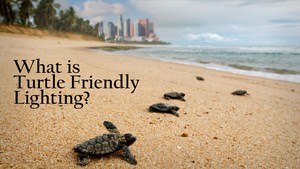Light pollution is difficult to combat without the right fixtures. Read on to find out what lights you can use to prevent this kind of pollution!
There is nothing that can set you in the right mood as walking through a city at night. The light pouring out from stores, displays, street lamps, and skyscrapers make the city look like a different place. The lights are the best attraction for nightlife and make for a magical experience.
But as you get outside the city you might see the beautiful lights in a very different way. They go from bright and attractive to a dull orange glow that blankets the city in an ugly haze. How does this happen? Keep reading for an explanation and find out ways to be part of the cure!
What is Dark Sky?

The Dark Sky lighting concept was started in Flagstaff, AZ (also known as Dark Sky City) during the 1950s. With over 50 years of development, the city has seen huge success with the movement and it has caused other cities to look more seriously into it. After all, who wouldn’t like to walk out during the night in the city and see stars as brightly as if you were in the country?
It was started when local astronomers started to worry that, due to the sky glow from nearby cities, a time would come when they couldn’t see the stars. This urged people to research the effects of artificial light and they quickly found out that if not treated immediately there would be many long-term consequences. So began the process of finding a solution that would come to be known as Dark Sky Lighting.
The idea behind the Dark Sky movement is to reduce light pollution by using non-wasteful light sources. The IDA (International Dark Sky Association) encourages the use of full cutoff fixtures and any other fixtures that reduce glare. They also encourage the use of timers on outdoor lighting. This will reduce the time the lights are on and ensure energy savings for your home.
What Kind of Fixtures are Dark Sky Compliant?

The best way to know if your fixture is Dark Sky approved is by looking for the badge on either the packaging or the light source itself. But if you are not sure where to look you can follow compliant lists like the one below and see if your light matches. If it doesn’t then you can be certain that it is not Dark Sky compliant.
Here is a comprehensive list of requirements for Dark Sky compliant lighting:
- Full cutoff fixtures
- Fully shielded outdoor lights
- Flush mounted fixtures
- Side shielded under canopy fixtures
- Low color temperatures of 3,000K or lower
- Fixtures that are able to either be used with dimmers or be set on a timer
Light sources that do not meet these requirements are as follows:
- Short wavelength lights (blue lights)
- Unshielded or poorly shielded fixtures
- Drop or sag lens canopy fixtures
- Louvered style fixtures
- Color temperatures over 3,000K
What is Light Pollution?

While we are all aware of types of pollution like air and water, not many people know that light is also a pollutant. Excessive use of artificial light has significant effects on the environment and climate, the same as any other pollutant. It is unfortunately a side effect of industrial civilization as its largest sources are from commercial properties that have multiple outdoor fixtures.
Light pollution happens through excessive and unnecessary use of artificial or man-made light sources. There are multiple types of these lights used in populated areas, such as street lamps and exterior fixtures. But instead of the lights being focused on the area where they are actually needed, 35% of light is being uselessly sent up into the sky. This creates the hazy sky glow that is seen long before you get to a populated area.
So how does light pollution affect the environment? Everyone knows that the sun is a good natural source of the energy we all need to stay healthy. It will also affect our sleep patterns which increase the risk for depression, sleep disorders, and more. By covering the sky with artificial light humans and animals do not have access to that natural light, which will have long term consequences if a change is not made.
It also negatively affects nocturnal animals who rely on the cover of darkness to hunt or forage for food. By taking that away these animals will have no way of operating under their natural instincts. Artificial lights also affect sea life by misdirecting creatures like sea turtles who map their way according to light. The same effect happens to birds that navigate according to the moon and stars.
Needless to say, light pollution is a real problem that needs to be addressed sooner than later. You can be part of the change by switching out your fixtures with Dark Sky compliant lighting. Start doing your part today!






